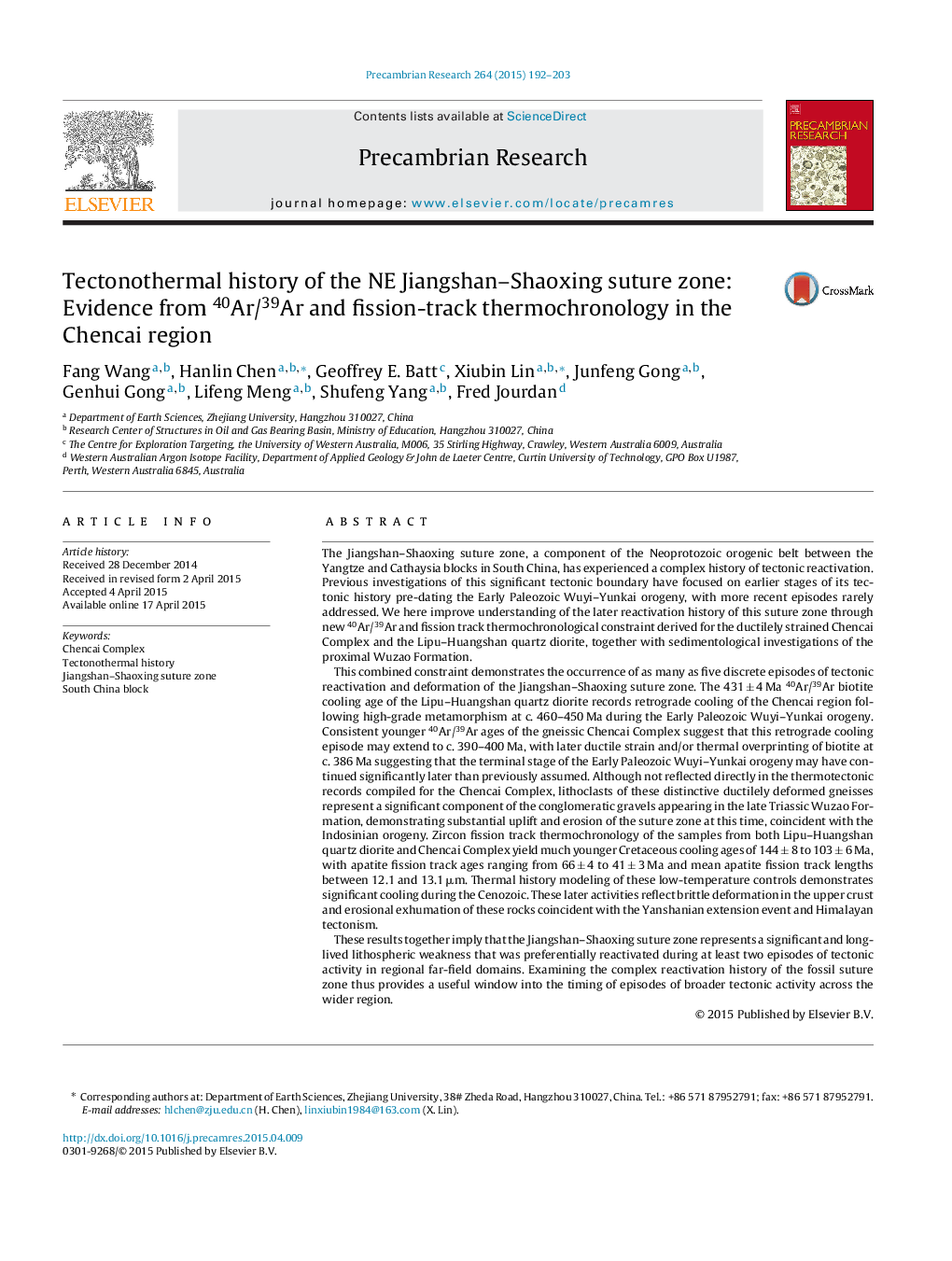| کد مقاله | کد نشریه | سال انتشار | مقاله انگلیسی | نسخه تمام متن |
|---|---|---|---|---|
| 4722683 | 1639611 | 2015 | 12 صفحه PDF | دانلود رایگان |

• Five episodes of events are documented in the J–S suture zone.
• The 40Ar/39Ar ages record Caledonian retrograde cooling and ductile deformation.
• Lithoclasts in Wuzao Form imply L. Triassic erosion of the suture zone.
• ZFT & AFT ages document brittle deformation in Cretaceous and Cenozoic.
• The results indicate episodes of reactivation of the suture zone.
The Jiangshan–Shaoxing suture zone, a component of the Neoprotozoic orogenic belt between the Yangtze and Cathaysia blocks in South China, has experienced a complex history of tectonic reactivation. Previous investigations of this significant tectonic boundary have focused on earlier stages of its tectonic history pre-dating the Early Paleozoic Wuyi–Yunkai orogeny, with more recent episodes rarely addressed. We here improve understanding of the later reactivation history of this suture zone through new 40Ar/39Ar and fission track thermochronological constraint derived for the ductilely strained Chencai Complex and the Lipu–Huangshan quartz diorite, together with sedimentological investigations of the proximal Wuzao Formation.This combined constraint demonstrates the occurrence of as many as five discrete episodes of tectonic reactivation and deformation of the Jiangshan–Shaoxing suture zone. The 431 ± 4 Ma 40Ar/39Ar biotite cooling age of the Lipu–Huangshan quartz diorite records retrograde cooling of the Chencai region following high-grade metamorphism at c. 460–450 Ma during the Early Paleozoic Wuyi–Yunkai orogeny. Consistent younger 40Ar/39Ar ages of the gneissic Chencai Complex suggest that this retrograde cooling episode may extend to c. 390–400 Ma, with later ductile strain and/or thermal overprinting of biotite at c. 386 Ma suggesting that the terminal stage of the Early Paleozoic Wuyi–Yunkai orogeny may have continued significantly later than previously assumed. Although not reflected directly in the thermotectonic records compiled for the Chencai Complex, lithoclasts of these distinctive ductilely deformed gneisses represent a significant component of the conglomeratic gravels appearing in the late Triassic Wuzao Formation, demonstrating substantial uplift and erosion of the suture zone at this time, coincident with the Indosinian orogeny. Zircon fission track thermochronology of the samples from both Lipu–Huangshan quartz diorite and Chencai Complex yield much younger Cretaceous cooling ages of 144 ± 8 to 103 ± 6 Ma, with apatite fission track ages ranging from 66 ± 4 to 41 ± 3 Ma and mean apatite fission track lengths between 12.1 and 13.1 μm. Thermal history modeling of these low-temperature controls demonstrates significant cooling during the Cenozoic. These later activities reflect brittle deformation in the upper crust and erosional exhumation of these rocks coincident with the Yanshanian extension event and Himalayan tectonism.These results together imply that the Jiangshan–Shaoxing suture zone represents a significant and long-lived lithospheric weakness that was preferentially reactivated during at least two episodes of tectonic activity in regional far-field domains. Examining the complex reactivation history of the fossil suture zone thus provides a useful window into the timing of episodes of broader tectonic activity across the wider region.
Journal: Precambrian Research - Volume 264, July 2015, Pages 192–203